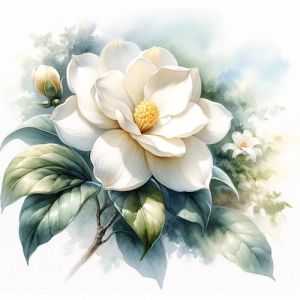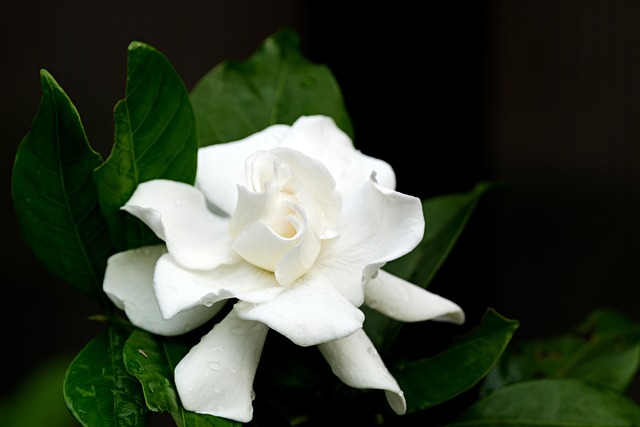Introduction to Gardenias
Welcome to our guide on Gardenias, an emblem of grace and fragrance in the gardening world. Known for their lush, white flowers and captivating aroma, Gardenias are a popular choice among gardeners. This guide will navigate you through the essentials of Gardenia care, ensuring your garden blooms with their elegance and charm.
A Brief History
Gardenias, with their lush white blossoms and intoxicating fragrance, have a rich history that intertwines with various cultures and traditions. Originally native to Asia and the Pacific Islands, Gardenias were named by Carl Linnaeus after Dr. Alexander Garden, an 18th-century naturalist. Their alluring beauty quickly captivated the interest of garden enthusiasts worldwide. In traditional Chinese medicine, Gardenias were used for their cooling and detoxifying properties, believed to alleviate certain bodily ailments. In Japan, they were used for dyeing clothes and food due to their natural yellow hue. The deep cultural significance of Gardenias is also evident in parts of the Pacific, where they symbolize peace and are used in important ceremonies and rituals. In the western world, the Gardenia became a symbol of purity and sweetness, often used in wedding bouquets and corsages. Over time, their role in perfumery became prominent, with their essential oils being highly prized for their rich, sweet fragrance. This enduring appeal makes Gardenias a timeless choice in both gardens and cultural expressions across the globe.
Botanical Overview
Understanding Gardenia’s Botanical Roots
- Common Name: Gardenia
- Scientific Name: Gardenia jasminoides
- Family: Rubiaceae Gardenias, belonging to the coffee family Rubiaceae, are evergreen shrubs with glossy, dark green leaves and large, creamy white flowers. Famed for their strong, sweet scent and waxy petals, they play a significant role in both gardens and perfumery.
Varieties of Gardenia
Exploring Different Gardenia Varieties
- Gardenia jasminoides (Cape Jasmine): Known for its large, fragrant white flowers and glossy leaves.
- Gardenia thunbergia: Features star-like flowers and a more woody stem structure.
- Gardenia brighamii: Native to Hawaii, known for its conservation status and unique beauty. Each variety offers distinct aesthetics and scents, fitting various garden styles and purposes.
Planting and Growth Conditions
Optimal Conditions for Gardenia Growth
- Sunlight: Prefer bright, indirect light or partial shade.
- Soil: Thrive in well-draining, acidic soil with a pH of 5.0 to 6.5.
- Planting Tips: Best planted in spring or fall, away from competing roots and with ample space to grow. Proper planting and situating are key to the successful growth of Gardenias.
Growing Zones for Gardenia
Understanding the appropriate growing zones for Gardenia plants is essential for their successful cultivation and bloom. Gardenias are known for their love of warm climates and sensitivity to cold.
Zone Suitability
- Ideal Hardiness Zones: Gardenias generally thrive in USDA Hardiness Zones 8 to 11. In these zones, they can be grown outdoors year-round without much risk of frost damage.
- Temperature Preferences: Gardenias prefer warmer temperatures, ideally between 60 and 70 degrees Fahrenheit during the day and 50 to 60 degrees at night.
- Cold Tolerance: While some Gardenia varieties can tolerate brief periods of colder temperatures, prolonged exposure to freezing conditions can be detrimental.
Considerations for Different Zones
- Zones 7 and Below: In colder zones, Gardenias can be grown as container plants and brought indoors during winter months to protect them from harsh temperatures.
- Zone 8 to 11: In these optimal growing zones, Gardenias can flourish in outdoor gardens. They should be planted in a location that provides protection from the hot afternoon sun and cold winds.
Microclimate Impact
- Protection from Elements: In borderline zones, providing shelter from strong winds and using mulch to protect roots from temperature extremes can be beneficial.
- Soil and Moisture: Regardless of zone, Gardenias require well-draining, acidic soil and consistent moisture. Proper soil conditions are crucial to prevent root rot and other diseases.
Indoor Cultivation
- Growing Indoors: For those in cooler climates, Gardenias can be successfully grown indoors with proper care. They need bright, indirect light and high humidity, which can be maintained with a humidifier or pebble tray.
By selecting the right Gardenia variety for your specific zone and creating an ideal growing environment, you can enjoy the lush beauty and enchanting fragrance of these plants. Local nurseries and extension services can provide additional guidance tailored to your region’s climate and conditions.
Care and Maintenance
Essential Care Tips for Gardenias
- Watering: Keep soil consistently moist, but avoid waterlogging.
- Fertilizing: Use an acid-based fertilizer suitable for Gardenias, especially during growth periods.
- Pruning: Light pruning to maintain shape and remove any yellow leaves. Regular and attentive care will ensure your Gardenias flourish with vibrant blooms.
Benefits and Uses
The Multifaceted Appeal of Gardenias
- Aesthetic Value: Adds elegance and a luxurious scent to gardens and indoor settings.
- Perfumery: The flowers are highly valued in the fragrance industry for their rich aroma.
- Traditional Uses: In some cultures, Gardenias are used for their purported medicinal properties. Gardenias not only enhance the beauty of your garden but also bring cultural and functional value.
Potential Problems
Navigating Common Issues with Gardenias
- Pests: Watch out for aphids, mealybugs, and whiteflies.
- Diseases: Susceptible to root rot and fungal issues, especially in overly wet conditions.
- Environmental Stress: Sensitive to temperature changes and improper watering. Understanding and managing these challenges will help keep your Gardenias healthy and thriving.
Conclusion
Gardenias offer more than just visual appeal; their intoxicating fragrance and elegant blooms are a testament to nature’s beauty. With proper care and attention, they can become a highlight in your garden, providing a sense of peace and natural elegance. Whether you are an experienced gardener or just starting, Gardenias are a rewarding addition to your horticultural endeavors.
Gardenia FAQ
- What are Gardenias and where do they originate? Gardenias, known for their creamy white flowers and strong fragrance, are native to tropical and subtropical regions of Africa, Asia, Madagascar, and the Pacific Islands.
- What are the best growing conditions for Gardenias? Gardenias thrive in well-draining, acidic soil, prefer partial shade to full sun, and require consistent moisture. They do best in warm, humid climates.
- How do I know if my soil is right for Gardenias? Test your soil’s pH level – Gardenias need acidic soil with a pH between 5.0 and 6.5. Amend with sulfur or peat moss if it’s too alkaline.
- Can Gardenias be grown in pots? Yes, Gardenias can be successfully grown in pots, which is especially useful in colder climates where they can be moved indoors during winter.
- How often should I water my Gardenia plant? Water Gardenias regularly to keep the soil consistently moist but not waterlogged. They are sensitive to both drought and overwatering.
- What type of fertilizer is best for Gardenias? Use an acid-based fertilizer formulated for Gardenias or rhododendrons. Fertilize in spring and summer, following the label instructions.
- How do I prune Gardenias and when is the best time? Prune Gardenias right after their main flowering season ends to shape the plant and remove any dead flowers or branches.
- Why are the leaves on my Gardenia turning yellow? Yellow leaves can be a sign of over-watering, under-watering, poor soil drainage, or a nutrient deficiency, typically iron caused by high soil pH.
- Are Gardenias susceptible to any diseases or pests? Gardenias can be affected by pests like aphids, spider mites, and whiteflies, and diseases like root rot and sooty mold.
- How do I use Gardenias in landscaping? Gardenias make excellent additions to mixed borders, fragrance gardens, and can be used as hedge plants. Their beautiful flowers and fragrance make them a standout in any garden setting.
1 / 2
Recent Posts

The Power of Mounding: An Essential Gardening Technique for Healthy Plants

The Ultimate Guide to Philodendron Birkin – Care, Tips, and Benefits

Watering Plants – Indoor Edition

The Advantages of Built-Up Garden Beds: A Gardener’s Best Friend

The Secret Weapon for Lush Blooms: How to Create the Perfect Fertilizer Schedule












You must be logged in to post a comment.